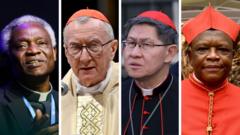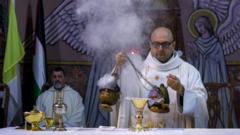Pope Francis's funeral marks a significant shift in papal traditions, showcasing a blend of simplicity and historical continuity, as millions gather to honor his memory at St. Peter's Basilica.**
The Evolution of Papal Funerals: A Shift Towards Simplicity**

The Evolution of Papal Funerals: A Shift Towards Simplicity**
Analyzing the changes in pope Francis's funeral rites, reflecting modern sensibilities amid enduring traditions.**
In a poignant juxtaposition of tradition and modernity, the funeral of Pope Francis illustrates a significant evolution in the ceremonial practices of the Vatican. While the visual aesthetics of the Swiss Guards remain reminiscent of the Medici era, the current papal coffin represents a marked departure from the intricate designs of the past— a simplification that Francis himself initiated.
This transformation aligns with the sentiments of a contemporary society that follows such pivotal events in real-time, with thousands traveling to St. Peter’s Square to pay homage to the late pope. The now simpler rituals serve as a bridge between the centuries-old customs of the Church and the desires of a modern congregation looking for authenticity even in the farewells.
Historically speaking, the papal funeral rituals embodied grandeur and spectacle, but Francis’s unique decisions reflect a thirst for humility. His coffin, notably less ornate and situated on a lower pedestal inside St. Peter's Basilica, underscores this ethos. Not only did it eliminate the lavish procession typical of popes before him, but Francis also opted for a burial at Santa Maria Maggiore, where he often prayed—hence indicating a desire for personal connection over tradition.
Moreover, the absence of a private viewing for cardinals and dignitaries signifies a willingness to break away from ostentatious traditions. The gesture resonates with the pope’s living legacy of approaching the global community with humility and accessibility. Ultimately, while the spiritual and historical significance of papal ceremonies endures, Pope Francis's funeral heralds a shift towards more understated rituals that appeal to the evolving sensibilities of the faithful. In remembering Francis, the world witnesses not just a farewell to a leader but a transitional moment for the Catholic Church as it redefines its place in a contemporary context.
This transformation aligns with the sentiments of a contemporary society that follows such pivotal events in real-time, with thousands traveling to St. Peter’s Square to pay homage to the late pope. The now simpler rituals serve as a bridge between the centuries-old customs of the Church and the desires of a modern congregation looking for authenticity even in the farewells.
Historically speaking, the papal funeral rituals embodied grandeur and spectacle, but Francis’s unique decisions reflect a thirst for humility. His coffin, notably less ornate and situated on a lower pedestal inside St. Peter's Basilica, underscores this ethos. Not only did it eliminate the lavish procession typical of popes before him, but Francis also opted for a burial at Santa Maria Maggiore, where he often prayed—hence indicating a desire for personal connection over tradition.
Moreover, the absence of a private viewing for cardinals and dignitaries signifies a willingness to break away from ostentatious traditions. The gesture resonates with the pope’s living legacy of approaching the global community with humility and accessibility. Ultimately, while the spiritual and historical significance of papal ceremonies endures, Pope Francis's funeral heralds a shift towards more understated rituals that appeal to the evolving sensibilities of the faithful. In remembering Francis, the world witnesses not just a farewell to a leader but a transitional moment for the Catholic Church as it redefines its place in a contemporary context.






















